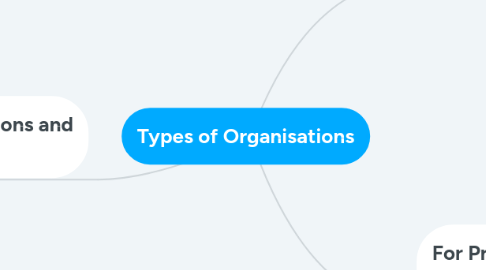
1. Other Organisations and Partnerships
1.1. Social Enterprise
1.1.1. Organisations that engage in business activity but also try to improve society. They can be profit organisation non-profit organisations or corporations..
1.1.1.1. Advantages: Financial independence, grow activities, improve ability to achieve goals and make donations.
1.1.1.2. Disadvantages: Competition, no finance, no market, no profit
1.2. Cooperatives
1.2.1. Organisation owned and runned by members who share a common interest.
1.2.1.1. Advantages: Reduce cost, provide services that profit organisations not consider profitable.
1.2.1.2. Disadvantages: Lack of secrecy, lack of interest, corruption
1.3. Microfinance providers
1.3.1. They provide financial services to people with limited means.
1.3.1.1. Advantages: Reduce failure and strenghtens force on finance, promote business
1.3.1.2. Disadvantages: Some may quit, use business not in an ethic way,
1.4. Public Private Partnership
1.4.1. Arrangement where the public sector request help from private sector to accomplish goals more easily
1.4.1.1. Advantages: permit the completition of projects, share rewards, innovation
1.4.1.2. Disadvantages: Expensive, agreements may not be appropiate in certian sectors
2. Non Profit Organisations
2.1. NGO's
2.1.1. Organisation that has the mision to benefit the society. They are not controlled by governement.
2.1.1.1. Advantages: Are private organisations, large contributors, not a political party, reclute experts, communicate in all levels
2.1.1.2. Disadvantages: Restriction in projects, replicability of idea, restrict degree of participation
2.2. Charities
2.2.1. Organisations devoted to helping those in need of finalcial or disability circumstances.
2.2.1.1. Advantages: Help improve society, receive finance through campaigns, communicate globally.
2.2.1.2. Disadvantages: Donated goods dont reach destination, corruption, misguided investments
3. For Profit(Commercial) Organisations
3.1. Sole Trader
3.1.1. Individual who owns and runs a business
3.1.1.1. Advantages: Total control, Easy to set up, Owner keeps al profit
3.1.1.2. Disadvantages: Unlimited liability, Owner receives all loses, no help in decisions, limited access to finance
3.2. Partnership
3.2.1. Business between two or more people
3.2.1.1. Advantages: Shared responsibility, Complementary Expertise and contribute financing.
3.2.1.2. Disadvantages: Share profit, disagreements, unlimited liability
3.3. Corporations
3.3.1. It is an legal entity that has a legal status
3.3.1.1. Advantage: Limited liability, raise funds by selling shares, death or change in ownership does not affect the corporation
3.3.1.2. Disadvantages: Difficult and expensive to create, conflicts of interest, financial records need to be public.
